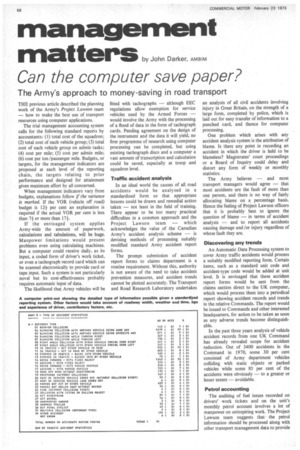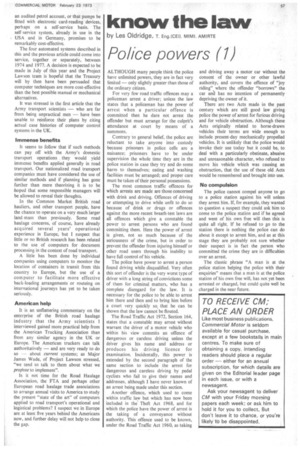management
Page 56

Page 57

If you've noticed an error in this article please click here to report it so we can fix it.
matters by John Darker, AMBIM
Can the computer save paper?
The Army's approach to money-saving in road transport
THE previous article described the planning work of the Army's Project Lawson team — how to make the best use of transport resources using computer applications.
The trial management accounting system calls for the following standard reports by accountants: (1) total cost of the squadron; (2) total cost of each vehicle group; (3) total cost of each vehicle group on admin tasks; (4) cost per mile; (5) cost per admin mile; (6) cost per ton /passenger mile. Budgets, or targets, for the management indicators are proposed at each level of the reporting chain, the targets relating to prior performance and designed for attainment given maximum effort by all concerned.
When management indicators vary from budgets, explanations follow ff the variance is marked If the VOR (vehicle off road) budget is 121 per cent an explanation is required if the actual VOR per cent is less than 7+ or more than 17+.
If the envisaged system applies Army-wide the amount of paperwork, calculations and tabulations, will be huge. Manpower limitations would present problems even using calculating machines. But a computer could receive daily, as its input, a coded form of driver's work ticket, or even a tachograph record card which can be scanned electronically to provide card or tape input. Such a system is not particularly novel but its cost-effectiveness probably requires automatic input of data.
The likelihood that Army vehicles will be fitted with tachographs — although EEC regulations allow exemption for service vehicles used by the Armed Forces — would involve the Army with the processing of a flood of data in the form of tachograph cards. Pending agreement on the design of the instrument and the data it will yield, no firm programme of research using computer processing can be completed, but using existing tachograph discs and a computer a vast amount of transcription and calculation could be saved, especially at troop and squadron level.
Traffic accident analysis In an ideal world the causes of all road accidents would be analysed in a standardized form so that appropriate lessons could be drawn and remedial action taken — not least in the field of training. There appear to be too many practical difficulties in a common approach and the Project Lawson team -which acknowledges the value of the Canadian Army's accident analysis scheme — is devising methods of processing suitably modified standard Army accident report forms.
The prompt submission of accident report forms to claims department is a routine requirement. Without this, authority is not aware of the need to take accident prevention measures, and accident trends cannot be plotted accurately. The Transport and Road Research Laboratory undertakes an analysis of all civil accidents involving injury in Great Britain, on the strength of a large form, completed by police, which is laid out for easy transfer of information to a punched card, and thence for computer processing. One problem which arises with any accident analysis system is the attribution of blame. Is there any point in recording an accident in which the driver is held to be blameless? Magistrates' court proceedings or a Board of Inquiry could delay and distort any form of weekly or monthly statistics.
The Army believes — and most transport managers would agree — that most accidents are the fault of more than one person, and there is no way of fairly allocating blame on a percentage basis. Hence the feeling of Project Lawson officers that it is probably best to ignore the question of blame — in terms of accident analysis — and to report all accidents causing damage and /or injury regardless of whose fault they are.
Discovering any trends An Automatic Data Processing system to cover Army traffic accidents would process a suitably modified reporting form. Certain items, such as a standard unit code and accident-type code would be added at unit level. It is envisaged that these accident report forms would be sent from the claims section direct to the UK computer, which would process them into a periodical report showing accident records and trends in the relative Commands. The report would be issued to Commands and other interested headquarters, for action to be taken as soon as any adverse trends become distinguishable.
In the past three years analysis of vehicle accident records from one UK Command has already revealed scope for accident reduction. Out of 3400 accidents in the Command in 1970, some 30 per cent consisted of Army department vehicles colliding with static objects or parked vehicles while some 85 per cent of the accidents were obviously — to a greater or lesser extent — avoidable.
Petrol accounting The auditing of fuel issues recorded on drivers' work tickets and on the unit's monthly petrol account involves a lot of manpower on uninspiring work. The Project Lawson team suggests that • the petrol information should be processed along with other transport management data to provide an audited petrol account, or that pumps be fitted with electronic card-reading devices, perhaps on a self-service basis. The self-service system, already in use in the USA and in Germany, promises to be remarkably cost-effective.
The four automated systems described in this and the previous article could come into service, together or separately, between 1974 and 1977. A decision is expected to be made in July of this year and the Project Lawson team is hopeful that the Treasury will by then have been persuaded that computer techniques are more cost-effective than the best possible manual or mechanical alternatives.
It was stressed in the first article that the Army transport scientists — who are far from being unpractical men — have been unable to reinforce their plans by citing actual case histories of computer control systems in the UK.
Immense benefits It seems to follow that if such methods can pay off with the Army's domestic transport operations . they would yield immense benefits applied generally in road transport. Our nationalized road transport companies must have considered the use of similar methods and if planning has gone further than mere theorizing it is to be hoped that some responsible managers will be allowed to reveal their thoughts.
In the Common Market British road hauliers, and other transport people, have the chance to operate on a very much larger land-mass than previously. Some road haulage concerns, of course, have already acquired several years' operational experience in Europe, but I suspect that little or no British research has been related to the use of computers for document processing in the context of road transport.
A little has been done by individual companies using computers to monitor the location of containers in transit from this country to Europe, but the use of a computer to facilitate more effective back-loading arrangements or routeing on international journeys has yet to be taken seriously.
American help It is an unflattering commentary on the enterprise of the British road haulage industry that the Army scientists I interviewed gained more practical help from the American Trucking Association than from any similar agency in the UK or Europe. The American truckers can talk authoritatively — and are very ready to do so — about current systems; as Major James Wade, of Project Lawson stressed, "we tend to talk to them about what we propose to implement".
Is it not time for the Road Haulage Association, the FTA and perhaps other European road haulage trade associations to arrange annual visits to America to study the present "state of the art" of computers applied to road transport's operational and logistical problems? I suspect we in Europe are at least five years behind the Americans now, and further delay will not help to close the gap.
































































































